Add your feed to SetSticker.com! Promote your sites and attract more customers. It costs only 100 EUROS per YEAR.
Pleasant surprises on every page! Discover new articles, displayed randomly throughout the site. Interesting content, always a click away
Carter's My Plumber
On Time, Fixed Right, with Courtesy, Respect, and A Smile!Key Questions to Ask Before Hiring an Indianapolis Plumber for Sewer Line Fixes 3 Apr 2025, 12:39 pm
A sewer line problem is more than just a big headache–it’s a situation that can lead to costly water damage, bad odors, and even health hazards if they are not repaired promptly and correctly.
However, not all plumbers have the skills or tools necessary for complex sewer line fixes. And choosing the wrong one could mean temporary fixes, repeated repairs, or unexpected expenses.
Before hiring just any plumber that you happen to find while searching Google, it’s essential to ask the right questions to ensure they have the experience, credentials, and technology to get the job done right the first time. This guide will walk you through key questions to ask, helping you find licensed plumbers in Indianapolis who can provide high-quality, long-term sewer line solutions.
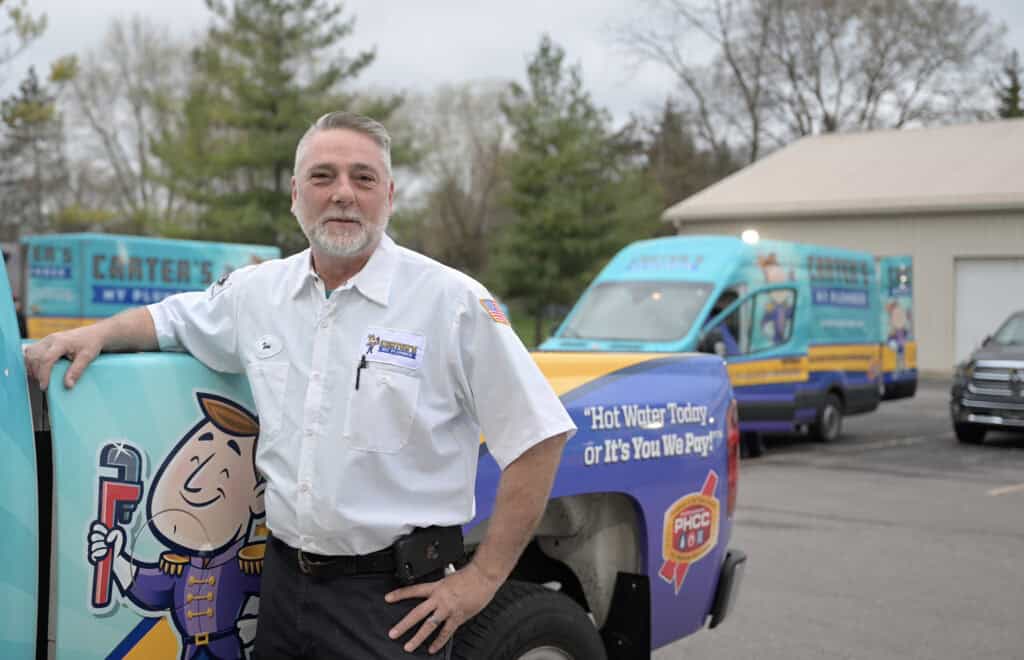
Here are the key questions to ask:
1. Are You Licensed and Insured?
Hiring a licensed and insured plumber is key to ensuring your sewer line repairs meet local regulations and protect you from liability. A valid license proves the plumber has the necessary training and experience, while insurance covers potential damages or injuries during the job.
Before committing to using a plumber, ask for proof of licensing and insurance. A reputable plumber will have no issue providing this documentation. Be cautious of any plumber who hesitates or refuses to show credentials–know that this is a huge red flag.
Choosing a licensed and insured professional gives you peace of mind and helps prevent costly mistakes.
2. What Experience Do You Have with Sewer Line Repairs?
Sewer line repairs require specialized expertise beyond basic plumbing work. A plumber with experience in sewer line repairs will know how to diagnose issues accurately and use the best repair methods.
When vetting a plumber, ask:
- How many sewer line repairs have you completed?
- Do you specialize in trenchless repairs?
- What types of sewer line issues have you handled?
Be wary of plumbers who give vague responses or lack experience with trenchless technology. Choosing a plumber with proven sewer line expertise ensures the job is done correctly and efficiently.
3. Do You Offer Camera Inspections?
A camera inspection is one of the most effective ways to diagnose sewer line problems before starting repairs. High-resolution cameras allow plumbers to pinpoint blockages, cracks, or collapsed sections without invasive digging.
When evaluating a plumber, ask:
- Do you use high-resolution cameras for sewer inspections?
- Will I receive a video or report of the inspection findings?
- How do you use the inspection results to determine the best repair method?
If you’re speaking with a plumber who appears to use guesswork instead of diagnostic tools, head in the opposite direction. Ultimately, a thorough camera inspection confirms accurate repairs and prevents unnecessary expenses.
4. What Repair Methods Do You Use?
Sewer line repairs can be completed using traditional excavation or modern trenchless methods. The right approach depends on the extent of the damage, your budget, and how much disruption you’re willing to tolerate.
Trenchless repairs, such as pipe lining or pipe bursting, often minimize digging and restore pipes more efficiently.
When choosing a plumber, ask:
- Do you offer trenchless repair options like pipe lining or pipe bursting?
- How do you determine whether trenchless or excavation is the best option?
- What are the cost differences between these methods?
Avoid contracting with a plumber who only offers excavation. They may not have the expertise or equipment to provide for less invasive, cost-effective services.
5. Do You Provide Upfront Pricing and Warranties?
Hiring a plumber without transparent pricing or warranty coverage can lead to unexpected costs and unreliable repairs.
A trustworthy plumber should offer a detailed estimate prior to starting work and back their repairs with a solid warranty. This ensures you understand what to expect with regard to total cost and have protection should issues present later on.
When speaking with a plumber, ask:
- Do you provide a written estimate before starting repairs?
- Are there any potential extra fees not included in the estimate?
- What warranties do you offer on parts and labor?
Do not work with a plumber who is vague about pricing, add surprise “nickel and dime” fees, or refuse to guarantee their work. Transparency and warranties are key signs of a reliable professional who knows what they’re doing.
Choose the Right Plumber for the Job
When faced with any sewer line issue, it’s important to hire the right plumber as this ensures quality work and prevents receiving an expensive bill when all is said and done.
By asking key questions about experience, repair methods, pricing, and warranties, you will be able to make an informed decision.
For expert sewer line repairs in Indianapolis, trust Carter’s My Plumber. Contact us today for reliable service, upfront pricing, and long-lasting solutions.
The post Key Questions to Ask Before Hiring an Indianapolis Plumber for Sewer Line Fixes appeared first on Carter's My Plumber.
Who Fixes Sewer Lines? Choosing the Right Expert for the Job 3 Apr 2025, 12:31 pm
Imagine waking up to a flooded basement or yard that all of a sudden has a foul odor and starts to smell like sewage. Not a pretty thing to picture, right?
Sewer line problems can quickly turn your home into a disaster zone. When it’s time for repairs, many homeowners wonder whether they should call a general plumber, a specialist, or even the city.
In this guide, we’ll explore who typically handles sewer line repairs, the most common problems you may face, and why choosing a trusted sewer line repair service in Indianapolis like Carter’s My Plumber ensures long-lasting solutions to keep your home safe and functional.
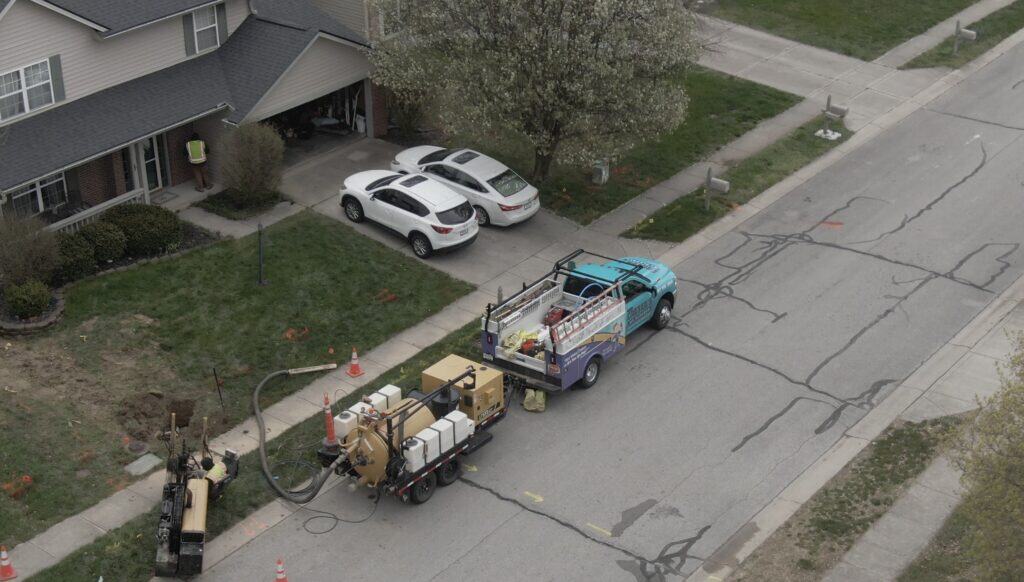
Who Typically Repairs Sewer Lines?
When it comes to sewer line repairs, it’s important to know who to call for the job. Not all plumbers have the same level of expertise or equipment, which can make a big difference in the outcome.
- General Plumbers: While general plumbers are great for basic plumbing issues like clogged drains or leaky faucets, they may lack the specialized tools and knowledge required for more complex sewer line repairs.
- Sewer & Drain Specialists: These professionals focus specifically on underground plumbing systems. They are equipped with advanced tools such as camera inspections, pipe relining, and trenchless technology, making them ideal for diagnosing and fixing sewer problems.
Why Hire a Licensed Sewer Repair Plumber?
Certified professionals have the training and proper equipment to handle the intricate details of sewer repairs. Their expertise ensures an accurate diagnosis and efficient repairs that minimize future problems.
Who is Responsible for Sewer Line Repairs?
- Homeowners are typically responsible for maintaining and repairing the sewer line from their house to the street connection.
- The city or utility company handles repairs for the main sewer lines that lie beyond the property line.
Common Sewer Line Problems
Sewer lines are susceptible to a variety of issues that can result in costly repairs if they are not addressed promptly. Here are the most common problems you may encounter:
- Tree Root Intrusion: Tree roots are naturally drawn to the moisture in sewer lines, and they can infiltrate pipes through small cracks or joints. Over time, roots can cause significant blockages, slow drainage, and even cracks in the pipes that lead to leaks.
- Pipe Corrosion or Aging: Older pipes, especially those made of metal or clay, are prone to corrosion. As they rust or deteriorate, they weaken and may collapse, causing leaks or blockages. Aging pipes often need to be replaced to prevent further damage.
- Blockages and Clogs: A buildup of grease, food waste, or non-flushable items like wipes or sanitary products can cause frequent clogs or backups. These blockages can obstruct the flow of waste and water, leading to foul odor and unsanitary conditions.
- Cracked or Collapsed Sewer Pipes: Over time, pipes may crack or collapse due to shifting soil, pressure from above, or the natural wear and tear of the materials. These issues require expert advice and professional repair methods, such as trenchless technology or excavation, to restore the sewer system to full functionality.
All of these issues can cause significant damage if not addressed quickly, which is why it’s key to call a professional plumber for sewer line replacement.
Signs You Need Sewer Line Repair
Identifying the signs of a broken sewer early on can save you from expensive repairs and extensive property damage. Here are the common indicators that you may need sewer line replacement:
- Frequent Drain Backups: If multiple drains, such as sinks, tubs, or toilets, are frequently backing up or draining slowly, it’s a sign of a deeper problem within the sewer line. This could indicate a drain blockage, root intrusion, or a collapsed pipe that is affecting the entire system.
- Sewer Gas Odors: A strong, foul sewage smell in or around your home is a clear warning sign that something’s wrong with your sewer line. Damaged pipes or broken seals may allow sewer gases to escape, creating an unpleasant and potentially hazardous environment.
- Unexplained Patches of Lush Grass or Sinkholes: Leaking sewage can lead to uneven fertilization, which may cause certain areas of your yard to become unnaturally green. Additionally, pooling water or collapsing soil can create sinkholes where the ground has eroded, signaling a serious sewer line problem.
- Slow-Draining Water: If water is draining slowly in multiple fixtures, and the issue persists over time, it may indicate a buildup of debris, tree roots, or structural damage within your sewer line. Left unchecked, this can lead to a complete blockage or pipe collapse.
If you become aware of any of these symptoms, it’s time to call in a plumbing company to diagnose and address the issue before it worsens.
Why Choose a Professional (And Not DIY)?
Attempting DIY sewer line repairs can be tempting, but the risks often outweigh the benefits. Here’s why you should rely on a professional plumber or trusted plumbing company instead:
DIY Sewer Repair Risks
- Specialized Tools and Expertise Required: Sewer line repairs need specific tools and knowledge that most homeowners don’t possess. Without the proper equipment, repairs can be ineffective or dangerous.
- Underground Utility Hazards: Digging without knowledge of municipal sewer lines could lead to accidental damage, causing further problems or even safety hazards.
- Temporary Fixes: DIY repairs often result in short-term solutions that can lead to bigger, more costly issues down the line, requiring even more work in the long run.
Professional Sewer Line Replacement Benefits:
- Accurate Diagnostics: Professionals use advanced tools like camera inspections to accurately diagnose the problem without unnecessary digging, saving time and reducing disruption.
- Advanced Techniques: With options like trenchless technology, plumbers can perform repairs with minimal disruption to your yard or landscaping.
- Long-Term Solutions: Licensed plumbers ensure that repairs are code-compliant, durable, and designed to last, preventing future issues and offering peace of mind.
How Carter’s My Plumber Approaches Sewer Repairs
At Carter’s My Plumber in Indianapolis, we take a systematic approach to sewer line repairs to ensure long-lasting solutions with minimal disruption.
Step 1: Camera Inspections
- Using high-resolution video equipment, we locate the exact cause of the problem, avoiding unnecessary digging and confirming accurate diagnosis.
Step 2: Repair Options
- Trenchless Technology: For minimal disruption, we offer pipe lining and pipe bursting, both effective trenchless methods.
- Traditional Excavation: In cases of severe damage, traditional excavation is used to access and repair pipes properly.
Step 3: Transparent Pricing and Customer Care
- We provide upfront estimates with no hidden fees and back our work with guaranteed quality and warranties that will let you sleep easy at night.
Don’t Suffer Through a Sewer Line Leak
Sewer line replacement issues can cause significant damage if not addressed promptly by a plumbing professional.
With expert diagnosis and repair methods, Carter’s My Plumber in Indianapolis provides expert advice and lasting solutions to all of your sewer line problems. If you suspect an issue, contact us today for fast, reliable, and affordable sewer line repair service.
FAQs
- Do regular plumbers fix sewer lines, or do I need a specialist?
While regular plumbers may handle basic plumbing, sewer line repair typically requires a specialist with advanced tools and expertise. - How much does it usually cost to repair a sewer line?
The cost of sewer line repair varies based on the extent of the damage, but it typically ranges from $1,500 to $4,000 or more. - Will sewer line repair damage my landscaping or driveway?
Traditional sewer line repairs may cause disruption to your landscaping or driveway, but trenchless methods minimize this risk. - What is trenchless sewer line repair, and does Carter’s My Plumber offer this service?
Trenchless sewer line repair is a minimally invasive method that doesn’t require large excavations, and yes, Carter’s My Plumber offers this service. - Does insurance typically cover sewer line repair costs?
Insurance coverage for sewer line repairs depends on your policy, but most homeowner’s insurance does not cover repair costs unless the damage is caused by a covered event.
The post Who Fixes Sewer Lines? Choosing the Right Expert for the Job appeared first on Carter's My Plumber.
Minimizing Sewer Line Damage in Indianapolis During Seasonal Freeze-Thaw Cycles 17 Mar 2025, 2:42 pm
Winter in Indianapolis brings more than just frigid temperatures–the season also brings the risk of sewer line damage due to freeze-thaw cycles.
When the water inside pipes freezes, it expands, which puts pressure on the pipe walls. Then, as the ice thaws, the ground shifts. This can cause cracks, misalignment, and even pipe collapses–and lead to leaks, sewage backups, and costly repairs if not addressed quickly.
Understanding how freeze-thaw cycles affect your sewer lines and taking preventative measures can save you from experiencing significant headaches down the road. As such, in this guide, we’ll explain the impact of freeze-thaw cycles on sewer lines, how to spot warning signs, and the best ways to protect your home.
For reliable repairs and maintenance, you can trust the expertise of the team at Carter’s My Plumber, the best plumbers in Indianapolis.

Understanding Freeze-Thaw Cycles and Their Impact
Freeze-thaw cycles occur when temperatures drop below freezing and then rise again, causing repeated expansion and contraction of water and soil. This process can significantly impact your sewer lines.
What Happens During a Freeze-Thaw Cycle:
- Water expands when it freezes, putting pressure on the walls of your sewer pipes.
- When the ice thaws, the ground shifts, which can misalign or crack the pipes.
Why Sewer Lines are Vulnerable:
- Older clay or metal pipes are more prone to cracking under pressure.
- Improper drainage can cause standing water around the pipes, which increases the risk of freezing and damage.
This repeated stress can weaken the structural integrity of your sewer system, leading to leaks, blockages, and expensive repairs if not addressed quickly.
Preventative Measures to Protect Sewer Lines
Protecting sewer lines from freeze-thaw damage requires a combination of insulation, proper drainage, soil stabilization, and root management. Taking these steps can prevent the need for repairs and keep your system running smoothly.
- Insulate exposed pipes: Use foam pipe insulation to protect vulnerable areas, especially those in unheated basements, crawl spaces, or near exterior walls. Insulation helps maintain a stable temperature and reduces the risk of freezing and cracking.
- Ensure proper drainage: Keep gutters and downspouts free from leaves and debris to prevent water from pooling near your sewer lines. Standing water increases the risk of freezing and puts added pressure on pipes when the ground shifts.
- Stabilize the soil: Freeze-thaw cycles can cause soil to expand and contract, which may misalign or crack sewer pipes. Some best practices include using landscaping techniques like planting grass or using mulch to keep soil in place. Additionally, consider adding gravel or drainage-friendly materials around pipes to prevent erosion and improve stability.
- Manage tree roots: Tree roots naturally seek out moisture, which can lead them to infiltrate and damage sewer lines. Therefore, keep large trees a safe distance from your sewer system and also think about installing root barriers to block roots from growing close to pipes.
Signs of Freeze-Thaw Damage
Recognizing the signs of freeze-thaw damage early can prevent more serious problems from happening.
One of the first signs is slow drainage or backups–if your sinks, toilets, or tubs are draining more slowly than usual, shifting or cracked pipes could be to blame.
Unpleasant odors coming from your drains or yard may also indicate that sewage is leaking from a damaged pipe.
You may also notice visible cracks or sinkholes forming in your yard, which can happen when thawing ground causes pipes to shift or break.
Finally, another common indicator is a sudden increase in water bills without a clear explanation, suggesting that water is escaping through a crack in the line.
If you spot any of these warning signs, it’s important to act quickly to prevent further damage and plumber’s bills.
When to Call a Professional
Knowing when to call a plumber can save you time, money, and additional damage to your sewer lines. Sewer lines repairs require specialized equipment for accurate diagnosis and effective repair.
Professionals use advanced tools, such as sewer cameras, to identify cracks, misalignments, and other issues caused by freeze-thaw cycles.
How Carter’s My Plumber Can Help in Indianapolis:
- Camera inspections: Identify the exact location and severity of the damage.
- Trenchless repair methods: Minimize disruption by fixing pipes without extensive excavation.
- Fast response: Carter’s My Plumber offers quick, reliable service to Indianapolis homeowners to prevent further damage and restore your sewer system efficiently.
Protect Your Sewer Lines This Winter
Protecting your sewer lines from freeze-thaw damage is essential to avoiding costly repairs and maintaining a high-quality plumbing system in Indianapolis.
If you suspect damage or want to prevent future issues, Carter’s My Plumber is here to help. Contact us for expert repair and maintenance.
The post Minimizing Sewer Line Damage in Indianapolis During Seasonal Freeze-Thaw Cycles appeared first on Carter's My Plumber.
How to Fix a Cracked Sewer Pipe 10 Mar 2025, 10:58 am
A broken sewer pipe is more than just a minor plumbing issue–it can lead to foul odors, persistent leaks, and even structural damage if left unchecked. Homeowners may first notice slow drains, wet spots in the yard, or an unexplained spike in their water bill, all of which can signal a problem with the sewer line.
Cracks in sewer pipes can develop due to aging materials, ground shifting, extreme temperature changes, or invasive tree roots seeking moisture. While some small cracks can be temporarily patched, more extensive damage often requires professional repair.
This guide will walk you through the steps to identify, temporarily fix, and permanently repair a cracked sewer pipe. We’ll also discuss when it’s best to call in an expert. If you’re facing a sewer pipe issue, Carter’s My Plumber is here to help as a trusted Indianapolis sewer line repair company.

Identifying a Cracked Sewer Pipe
A cracked sewer pipe can cause major disruptions in your home, but early detection can prevent costly repairs.
Watch for these common signs:
- Foul odors: The smell of sewage inside or outside your home may indicate a pipe leak.
- Slow drains or backups: If multiple drains are clogging frequently, a cracked pipe could be allowing debris buildup.
- Wet spots or sinkholes: Unexplained pooling water or sinking areas in your yard may signal a leak underground.
- Higher water bills: A sudden spoke in your water bill could mean wastewater is escaping from a cracked sewer line.
A variety of reasons can lead to sewer line issues, including:
- Aging cast iron pipes: Older pipes, especially clay or cast iron, become brittle over time.
- Tree roots: Roots natural seek out moisture and can infiltrate small pipe cracks, worsening the damage.
- Ground movement: Shifting soil, heavy traffic above the pipe, or freezing temperatures can cause pipes to crack or misalign.
Identifying these warning signals early can help you take action before the problem worsens.
Temporary Fixes for a Broken Sewer Pipe
If you discover a cracked sewer pipe, a temporary fix can help prevent further damage while you arrange for a professional plumber to repair it. For small cracks, applying epoxy or plumber’s putty can create a quick seal to stop leaks. These materials are water-resistant and can hold up for a short period, but they are not a permanent solution.
Another option is using a pipe wrap or rubber couplings to contain leaks. Pipe wraps are designed to reinforce weakened sections of the pipe, while rubber couplings provide a tight seal around the damaged area. These temporary measures can help minimize water damage and odors until a professional plumber can assess the situation.
However, some cases require more than a quick fix. If the crack is large, sewage is backing up into your home, or the pipe is severely misaligned, a full repair or replacement is necessary. Ignoring the problem can lead to costly structural damage and health hazards, making professional intervention essential.
Permanent Repair Methods
When it comes to fixing a broken sewer pipe, permanent repairs are central for long-term functionality. There are two main types of repairs: excavation and trenchless methods.
Excavation Repair
- Process: Involves digging up the ground to access the damaged sewer pipe, then removing the broken section and replacing it with new piping.
- Pros: This method is highly effective for severe cracks or broken pipes, providing a permanent fix for extensive damage.
- Cons: Excavation can be disruptive, requiring significant digging that may affect landscaping, driveways, or foundations. It can also be costly due to the need for labor, equipment, and potential restoration work.
Trenchless Repair Methods
Trenchless technology has become popular due to its less invasive nature, offering efficient repair solutions for cracked sewer pipes without large-scale excavation.
Pipe Relining
- Process: A resin-coated liner is inserted into the existing pipe and expanded to seal cracks from the inside. The liner hardens over time, creating a new, durable pipe within the old one.
- Ideal for: Moderate damage where the pipe is still structurally sound but needs reinforcement.
- Benefits: No need for major excavation, saving time, cost, and disruption. The process is cleaner and typically faster than traditional excavation.
Pipe Bursting
- Process: This method involves breaking apart the damaged pipe with a special bursting head while simultaneously pulling a new pipe into place.
- Ideal for: Severely cracked or deteriorating pipes that require full replacement.
- Benefits: This method requires fewer access points, and the process is quicker than excavation. It also avoids the needs for large digging areas, preserving the landscape and reducing labor costs.
Each repair method has its advantages, depending on the severity of the damage and the location of the pipe. Consulting with a professional plumber is key to determining the most effective and cost-efficient approach.
When to Call a Professional Plumber
Sewer pipe repairs are complex and require specialized tools and expertise to avoid further damage and ensure lasting results. Attempting DIY repairs can lead to costly mistakes and worsening of the plumbing issue.
How Carter’s My Plumber can assist in Indianapolis:
- Camera Inspections: Our team uses advanced camera technology to accurately assess the damage and locate the source of the problem.
- Expert Repairs: Whether you need trenchless or excavation repairs, we have the skills and equipment to handle any sewer pipe issue.
- Fast, Reliable Service: As an Indianapolis sewer line repair company, we offer prompt and dependable service, guaranteeing your sewer pipe is fixed with minimal disruption.
Preventing Future Sewer Pipe Cracks
To prevent future sewer pipe cracks, regular maintenance is key. Scheduling annual sewer inspections helps identify potential issues before they become major problem. Additionally, taking steps to prevent tree root intrusion is critical–keeping large trees away from sewer lines will reduce the risk of roots causing cracks.
Proper usage of your plumbing system is also important; avoid flushing non-biodegradable items or pouring grease down drains, as this can lead to blockages and pipe damage.
Don’t Let a Cracked Pipe Drain Your Wallet
Fixing a cracked sewer pipe promptly is necessary to avoid further damage and expensive repairs. If you’re dealing with a cracked sewer pipe in Indianapolis, trust Carter’s My Plumber for fast, reliable, and expert solutions.
Contact us today to ensure your plumbing is in top shape!
FAQs
- Can a sewer pipe be repaired? Yes, sewer pipes can be repaired using methods like excavation, trenchless pipe relining, or pipe bursting depending on the severity of the damage.
- How do you fix a cracked pipe without replacing it? A cracked pipe can be fixed using temporary solutions like epoxy, plumber’s putty, or pipe wraps, though permanent repairs may require professional intervention.
- Does homeowners insurance cover sewer lines? Homeowners insurance typically does not cover sewer line repairs unless the damage is caused by a covered event, such as a sudden and accidental break.
The post How to Fix a Cracked Sewer Pipe appeared first on Carter's My Plumber.
Emergency Preparedness: What to Do If Your Sewer Line Breaks in Indianapolis 12 Feb 2025, 5:57 pm
A sewer line break can strike at any time–often without warning and during the busiest time of day–creating chaos and absolute overwhelm for homeowners.
The sudden backup of sewage can cause water damage, release foul odors, and present considerable health risks.
In a stressful situation such as this, it’s important to know how to act quickly to prevent further destruction and contamination. Handling a sewer line break properly from the get-go can save time, money, and hassle–and that means contacting the best plumbers in Indianapolis.
Carter’s My Plumber is here to help guide homeowners through the necessary steps for emergency preparedness and provide expert solutions when a sewer line breaks and disaster strikes.
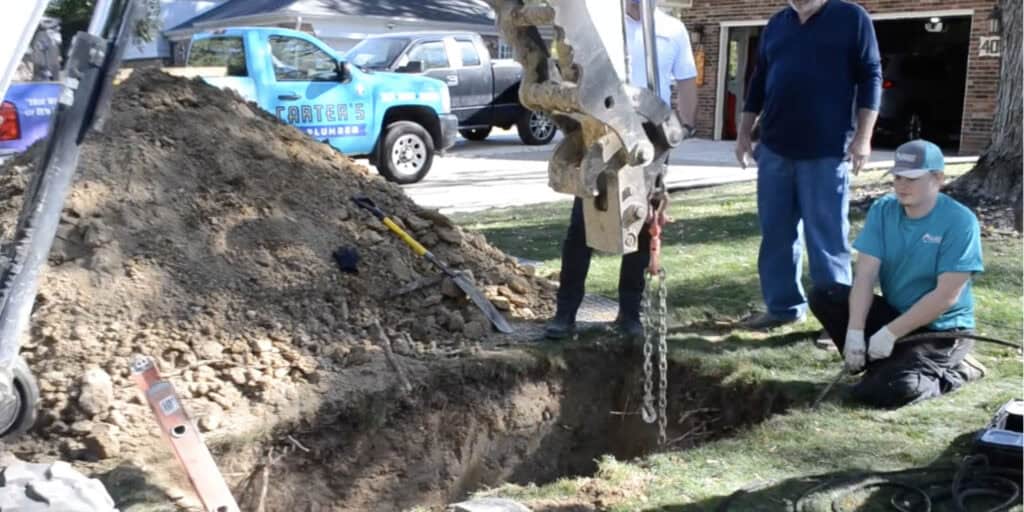
Immediate Steps to Take After a Sewer Line Break
If you experience a sewer line issue, it’s necessary to act immediately to mitigate the risk of future damage and prevent contamination involving human waste and the like.
Follow these steps ASAP:
- Shut off the water: The first thing to do is turn off the main water valve to stop additional water from entering the drain lines. This will prevent the problem from worsening.
- Avoid using drains: Do not flush toilets, run water in sinks, or use the shower. Using water will create additional pressure on the broken pipe, potentially causing more sewage backups and damage.
- Contain the damage: If possible, place towels, plastic sheets, or any available material around the affected area to block any sewer water from spreading into your home. This can help minimize water damage and the threat of contamination.
- Stay safe: Sewage is hazardous to your health and the health of your family. As such, avoid any contact with the water, and keep pets and family members away from the affected area to reduce exposure to harmful bacteria and pathogens.
Taking these immediate steps can help control the situation until you can call a professional plumber for sewer line replacement.
Identifying the Signs of Sewer Line Break
Recognizing the signs of a sewer line break early on can help you take action before the damage worsens.
Here are some common red flags:
- Foul odors: One of the first signs of a broken sewer is a strong, unpleasant sewage smell around your home or yard.
- Pooling water: If you notice sewage water backing up into your basement, yard, or lower-level areas, this could be a sign of potential issues.
- Slow drains or multiple clogs: Difficulty flushing toilet paper or draining sinks throughout your home may indicate a clog or a damaged pipe in the sewer line. Also be cognizant of gurgling noises that come from the sewer pipes.
- Cracks in foundation: Shifting or cracks in your foundation may occur if there is damage to the sewer line under your home, as water and pressure from the break can weaken the ground.
If you notice any of these signs, don’t wait as that can lead to extensive damage. Call a licensed plumber.
Calling for Professional Help
When facing a sewer line replacement, seeking an expert plumber is the best course of action. This professional can help prevent further damage and ensure a long-lasting solution.
Ultimately, sewer line repairs require specialized equipment and skills that most homeowners simply don’t have. A professional can quickly assess the damage using advanced tools like sewer cameras to pinpoint the exact location and nature of the problem. This allows for accurate diagnostics and helps avoid unnecessary excavation, additional repairs, and bigger plumbing bills.
If you’re facing a sewer line break in Indianapolis, Carter’s My Plumber offers a fast response to emergencies and uses modern trenchless repair methods to minimize disruptions to your property.
Preventative Measures to Avoid Future Breaks
Taking proactive steps to maintain your sewer line can help prevent future breaks and costly repairs.
Here are some key tips:
- Regular Inspections: Schedule annual sewer inspections to detect potential issues early and avoid emergencies.
- Proper disposal practices: Never flush non-flushable items, grease, or debris down the drains as they can cause blockages or pipe damage.
- Tree root management: Keep trees and shrubs at a safe distance from your sewer lines to prevent roots from infiltrating and damaging the pipes.
These approaches will help extend the life of your plumbing system and protect your property.
Act Fast When Faced with a Sewer Line Emergency
Sewer line breaks demand fast action and immediate attention to minimize damage and health risks. If you’re facing a sewer emergency in Indianapolis, trust Carter’s My Plumber for fast, reliable, and expert service. Contact us today for professional sewer repairs and ensure your home stays safe and secure.
The post Emergency Preparedness: What to Do If Your Sewer Line Breaks in Indianapolis appeared first on Carter's My Plumber.
How to Repair a Clay Sewer Line 3 Feb 2025, 5:51 pm
Prior to the 1980s, clay sewer lines were commonplace in residential homes. This was due to their durability and resistance to chemical corrosion. However, over time, these pipes can deteriorate, leading to a variety of plumbing issues.
Homeowners may need to repair their clay sewer pipes due to common problems like intrusion from tree roots, which can cause severe blockages, as well as cracks and shifting pipes that lead to leaks and misalignment.
While some homeowners may consider tackling these broken pipe repairs themselves, the process is labor intensive and requires specialized tools and expertise. Remember, mistakes can lead to costly damage and additional repairs.
That’s why professional help is often the best solution. Carter’s My Plumber specializes in sewer line repair the Indianapolis area—and offers expert inspections to restore your plumbing system efficiently and effectively.
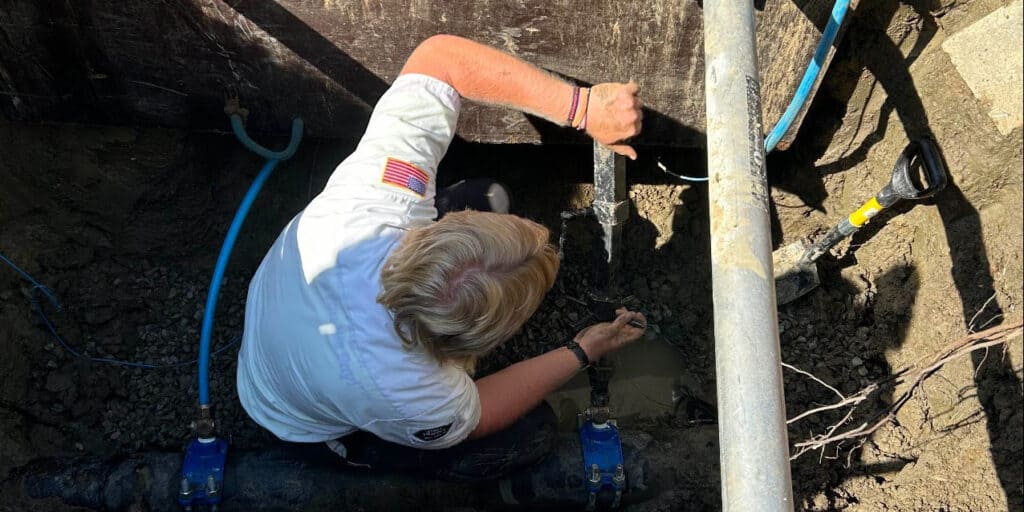
Understanding Clay Sewer Line Issues
Clay sewer pipes were widely used in older homes because of their durability, availability, and resistance to chemical corrosion. While they were a reliable choice for decades, these pipes over time can become faulty and are now prone to issues that can lead to expensive plumbing problems.
Recognizing the common challenges associated with clay pipes can help homeowners determine when repairs are needed and when full sewer line replacement is the best option.
Common Problems with Terracotta Pipes
- Tree Root Intrusion: The joints in clay pipes create small openings where tree roots can grow, causing severe blockages and potential pipe damage.
- Cracks and Breaks: Over time, clay pipes may become brittle and can develop cracks, leading to leaks and soil contamination.
- Shifting and Misalignment: Changes in soil conditions and natural ground movement can result in clay pipes shifting or disconnecting, leading to drainage problems.
When to Repair vs. Replace
- Minor Cracks and Localized Damage: This can often be repaired with pipe relining or spot replacements.
- Extensive Root Invasion or Large Fractures: This situation usually requires full pipe replacement for long-term durability.
- Severely Misaligned or Collapsed Pipes: This may necessitate trenchless pipe bursting or a complete sewer line replacement.
Assessing the severity of the damage through a sewer line inspection is key to determining the best course of action.
Steps to Repair a Clay Sewer Line
- Diagnosing the Problem: Use a sewer camera inspection to identify the damage. This will determine whether a pipe section needs to be repaired or if all drain pipes are damaged.
- Digging to Access the Pipe: Locate the exact location of the clay sewer line and dig a trench to expose the damaged section or sections. It’s necessary to consider the depth and complexity of excavation, which may require specialized equipment or assistance from a plumbing professional.
- Repair Methods: This is where it can get tricky and present challenges for homeowners, as there are multiple options, which include:
- Spot Repairs for Minor Damage: Remove the damaged clay pipes and replace them with PVC pipes or new clay pipe. Use rubber couplings or no-hub connectors to join old and new pipes.
- Pipe Lining for Moderate Damage: Insert a resin-coated liner inside the existing pipes to seal cracks and leaks. The benefit here is that this approach is less invasive and extends the lifetime of the pipes.
- Pipe Bursting for Severe Damage: Insert a new pipe while breaking apart the old clay pipe. This, in turn, replaces the entire line without extensive digging.
DIY Repair Challenges for Homeowners
Engaging in clay sewer pipe repairs on your own may seem like a way to save money, but the process is physically demanding and requires specialized tools. Without expert clay sewer pipe assistance from a professional plumber, DIY repairs can lead to costly mistakes and even safety hazards.
Here are some key challenges for homeowners to consider:
- Heavy Labor and Equipment: Digging to access the clay pipes and cutting them up requires professional-grade tools that most homeowners don’t have access to.
- Risk of Further Pipe Damage: Incorrect or faulty repairs can cause leaks, misaligned pipes, structural damage, or persistent blockages, which leads to bigger plumbing problems.
- Permit and Code Requirements: Many areas, including in Indianapolis, require permits and sewer line inspections. Improper or unauthorized work may violate local plumbing codes.
- Health and Safety Risks: Handling sewage, dirty water, or damaged pipes can expose you, as a property owner, to bacteria, mold, foul odors, and harmful gases.
For durable and long-lasting solutions, hiring experienced plumbers is often the safest and most cost-effective option.
Why Hire a Professional Plumber?
Hiring a qualified plumber to address clay pipe damage ensures expertise, efficiency, and long-term reliability.
Plumbers have the skills to quickly diagnose and fix issues, preventing further damage. They also use advanced technology like sewer cameras, trenchless repair methods, and hydro jetting to provide precise, minimally invasive solutions. In turn, damaging property–as well as city property–is less likely.
Furthermore, professional water line replacement also comes with warranties, giving homeowners peace of mind.
For Indianapolis residents, Carter’s My Plumber offers expert sewer line repair services with professional plumbers and modern techniques. Instead of risking expensive DIY mistakes, homeowners should let a pro handle the job for durable and long-lasting solutions related to clay pipe damage.
Contact a Reliable Plumber in Indianapolis
Proper clay sewer line repair minimizes the risk of experiencing other issues over time, including sewer backups, moisture in sewer pipes, blockages, leaks, and costly damage. While DIY repairs may seem like a good solution, they often lead to bigger problems based on the complexity of the work alone.
For safe, efficient, and high-quality sewer repair, it’s best to call a professional. If you require clay sewer line repair in Indianapolis, trust Carter’s My Plumber for reliable service and best-in-class customer satisfaction.
The post How to Repair a Clay Sewer Line appeared first on Carter's My Plumber.
How to Repair a Sewer Line Under a Slab 28 Jan 2025, 4:08 pm
A broken sewer line beneath a structure’s concrete slab is a serious issue that can lead to significant property damage and a hefty price tag if it is not addressed immediately.
When a sewer line fails under a slab, it can cause foul odors, water damage, and even foundation issues, potentially comprising the structural integrity of the home.
Common causes of sewer line damage under a slab foundation include shifting soil, pipe corrosion, and tree root intrusion, all of which can gradually weaken a home’s pipes over time. And while the thought of repairing a sewer line under a slab can feel overwhelming, understanding the process and available repair methods will help homeowners make informed decisions–and lessen anxiety.
For efficient and reliable solutions, seek a professional plumber for expert sewer line repair in Indianapolis.
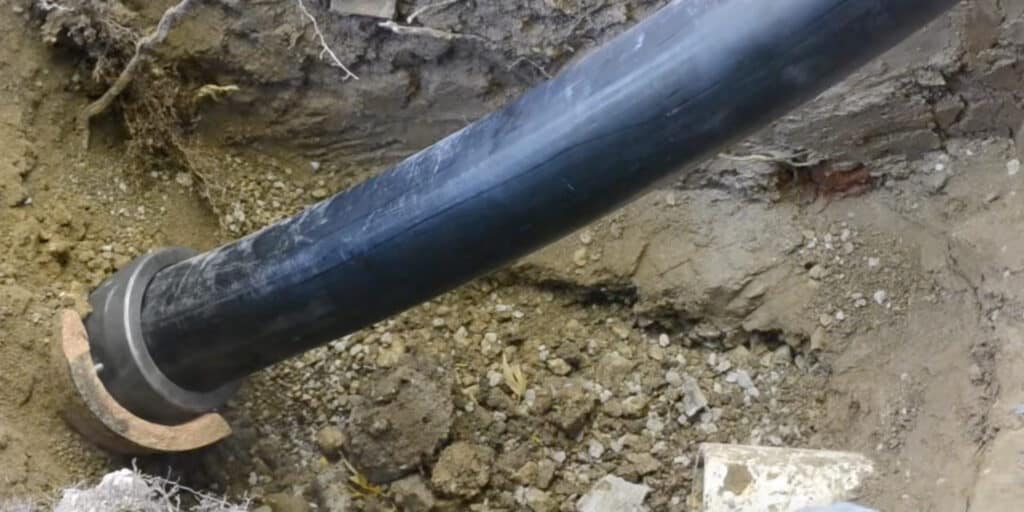
Signs of a Sewer Line Problem Under a Slab
Recognizing the signs of damage related to a sewer line problem under a slab early on can prevent major damage and expensive repairs.
Here are some of the noticeable symptoms to be aware of:
- Foul odors in the home or yard, which may indicate sewage backup or leaks in the sewer pipes.
- Slow drains or recurring clogs, particularly in multiple fixtures. This suggests that there’s a blockage in the drain lines or damage in the main sewer line.
- Water pooling on floors or wet spots on the concrete slab can indicate a leak in the sewer line, which is allowing wastewater to escape and seep into the foundation.
- Foundation cracks or settling due to soil erosion can occur when the ground beneath the slab shifts because of a leaking sewer line, leading to structural issues in the home.
If you notice any of these signs, it is imperative to have the sewer line inspected ASAP to avoid further damage to your property. Prompt attention can help mitigate high repair costs and preserve the integrity of your home.
Diagnostic Process for Identifying the Issue
A professional inspection by a skilled plumber is key when diagnosing a sewer line problem under a slab foundation. Attempting to diagnose or repair the issue without professional help can lead to major complications, expense, and unnecessary disruption to your home.
One of the most commonly used diagnostic tools is a sewer camera, which provides an internal video inspection of the pipes. This camera can be fed through the sewer line to pinpoint blockages, cracks, or other damage.
Leak detection equipment is another useful tool for locating water flow and pinpointing hidden leaks in the pipes. This equipment helps professionals detect water escaping from the system, even when it isn’t visible on the surface.
Ultimately, the severity and location of the damage will influence the best repair approach. For example, if the sewer leak issues are localized and accessible, trenchless repair methods may be an option. However, if the damage is extensive or deep under the slab foundation, traditional excavation may be needed for a more thorough fix.
Proper diagnostics are the first step in determining the most effective and cost-efficient repair solution.
Repair Methods for Sewer Lines Under Slabs
When repairing a sewer line under a concrete slab, there are several methods to consider. Here’s a quick overview of the most common approaches:
Traditional Excavation
- Process: Breaks through the slab to access and repair the damaged pipes.
- Pros: Provides direct access for a thorough repair.
- Cons: Expensive, disruptive, and time-consuming.
Trenchless Pipe Repair Methods
- Pipe Relining: This process inserts a resin-coated tube into the damaged pipe to form a new inner lining. It offers minimal disruption as well as cost-effectiveness. However, it’s not suitable for severely collapsed pipes.
- Pipe Bursting: Here, the old pipe is broken, and a new one is pulled into place. It completely replaces the pipe without extensive digging. But it does require access points on both sides of the damaged section.
These methods offer varied benefits depending on how severe the damage is–plumbing contractors can help determine the best approach.
Cost & Time Considerations
The cost of sewer line repair under a concrete slab can vary significantly depending on the replacement method used.
Traditional excavation typically ranges from $3,000 to $10,000, due to the labor-intensive process of breaking through the slab and removing large sections of flooring and foundation.
Trenchless methods, such as pipe relining or pipe bursting, are generally more cost-effective, with prices ranging from $2,000 to $4,000, as they require less labor and minimal disruption.
Several factors also influence the overall cost, including the length of the pipe needing repair, the location of the damage, and the chosen repair methods.
Additionally, traditional excavation tends to take longer, often requiring several days to complete, whereas trenchless methods can be done in a matter of hours to a couple of days, significantly reducing downtime and inconvenience.
Consult with a Professional Plumbing Expert
Ultimately, professional diagnostics are necessary when identifying and fixing broken pipes under a concrete slab.
Choosing the right approach ensures effective, long-term solutions and minimizes damage to your property.
If you suspect sewer line issues under a slab, don’t wait for the problem to get worse. Consult with the plumbing professionals at Carter’s My Plumber in Indianapolis. We have extensive expertise in slab repair and welcome the opportunity to set your mind at ease.
FAQs:
- How do you fix a broken pipe under a slab?
About the only way to fix a broken pipe under a slab is to bust the concrete up and repair the pipe and repair the concrete. - How long does it take to replace a sewer line under a concrete slab?
A typical sewer line replacement can take up to 3 days to repair under the slab, but it really depends on how much pipe is getting replaced. - How to fix the belly in the sewer line under the slab?
The only way to fix a belly is to locate where it is with special locating device and then to bust up the floor at that point and access it through busting up the floor. - What are the signs that a sewer line under a slab is damaged?
A sign of slab damage is if your drain is blocked or running slow. Then we would need to get eyes “camera” down the drain the see exactly the next plan of action - What are the repair options for a sewer line under a slab?
Depending on what type of pipe and access we have to it we can just repair a section of pipe - What is the least invasive method for sewer line repair?
Lease invasive would be to use our trenchless technology, if applicable - How much does it cost to repair a sewer line under a slab?
Average cost would be $3,000- 10,000 - Do I need permits to repair a sewer line under a slab?
It depends on where you are located but some municipalities do require a permit. We always make sure before starting any work if one is needed.
The post How to Repair a Sewer Line Under a Slab appeared first on Carter's My Plumber.
Water Heater Repair Cost Guide: Don’t Pay Too Much! (2025) 9 Jan 2025, 11:03 pm
How much will the water heater repair cost?
(2025 Update): 95% of the time, the main reason people call about a water heater problem is leakage, which is not repairable and we must replace it. The typical range for water heater replacement is between $1600 to $5500, averaging around $3,550. For the rest of the cases, the price tag on your electric water heater repair project, one of the most critical aspects, will be the specific part that requires work. The average cost of repairing a water heater is $506. *Prices vary based on the complexity of the circumstances.
Most of the time, homeowners put little thought into their water heater. As long as the unit works, it’s out of sight and out of mind. When the water heater is on the fritz, however, it becomes hard to ignore. A faulty water heater can adversely impact quality of life in a number of ways.
For example, hot showers will be out of the question. Some family members may forgo bathing altogether! Unwashed dishes may start to pile up. Laundry equipment won’t be as powerful in removing stains. It may feel like your home life has come to a complete stop.
The good news is that water heater issues can usually be fixed promptly. Is your water heater leaking? Is it simply not working as intended? Contact an experienced plumber who can diagnose the water heater problem. From there, you can get your water heater repaired or replaced.
As you consider this possibility, it’s natural to wonder about price. How much will the water heater repair cost? We’ll answer that question in this comprehensive guide.
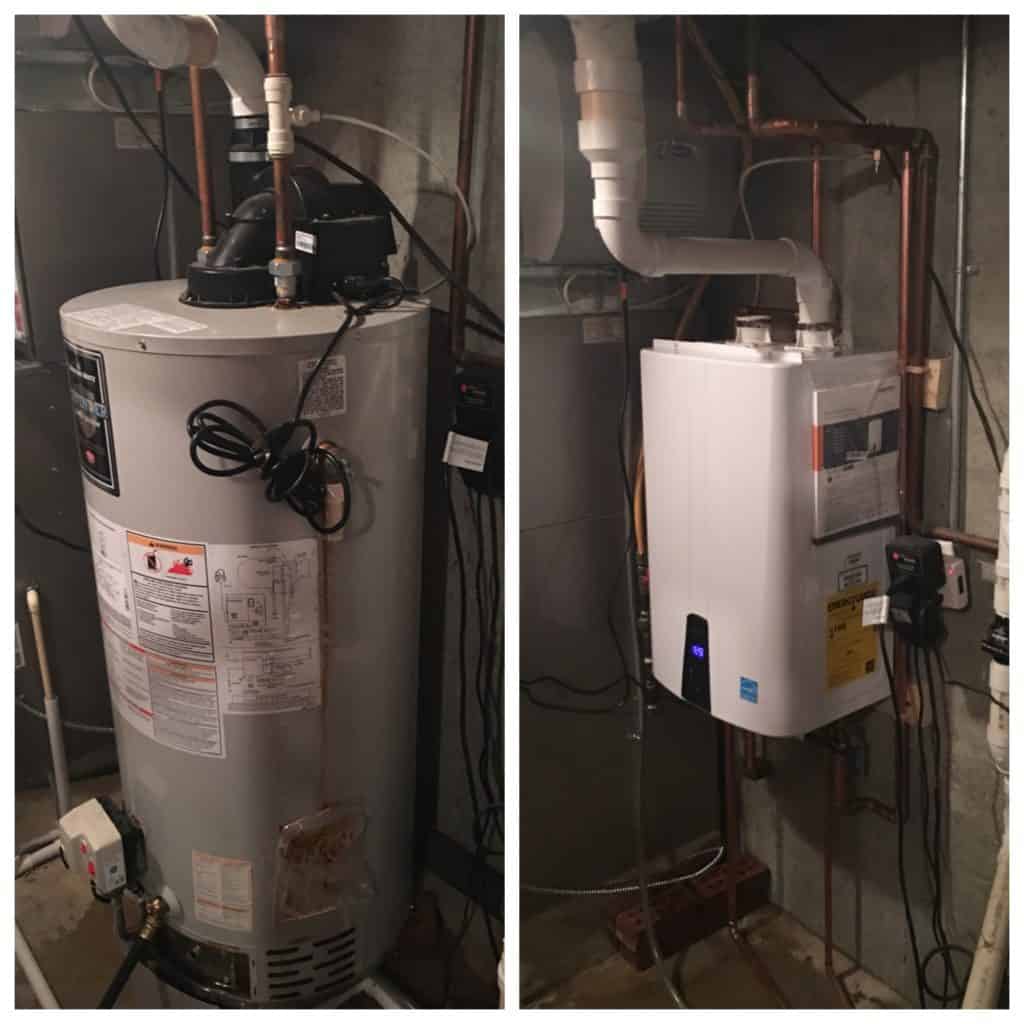
Water Heater Replacement vs. Repair
There are a number of factors that can determine the cost. One of the most important issues is whether you get your hot water heater repaired or replaced.
A good rule of thumb is that water heater’s life expectancy is 9 years. Without draining, water heaters that receive heavy use may not last quite as long. But 9 years is a good number to keep in mind.
If your water heater is more than 9 years old, and it starts giving you trouble, it will almost certainly be more cost-effective to replace it. Repairing it may be possible, but it could turn out to be just a short-term fix.
Another way of looking at it: If your unit is under seven years old, you will almost always want to repair it. Replacement probably won’t be necessary. But if your water heater is over seven years old, that’s where things get tricky. While it may be possible to repair it, it may or may not make financial sense to do so.
A skilled plumber will be able to advise you on the best way to get your hot water working again, without breaking the bank. That will be one of the determining factors in the cost of addressing your water heater problem.
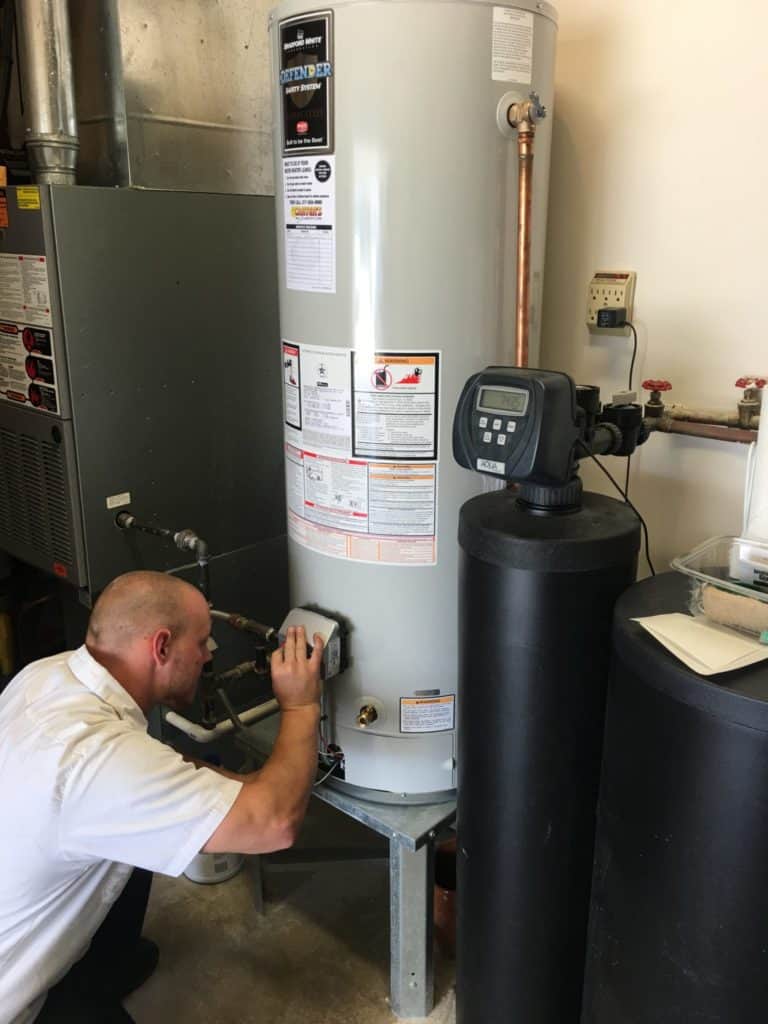
Common Problems That Leave You Without Hot Water
Something else to consider as you debate water heater repair or replacement cost: What’s the underlying problem?
There are several common problems that can cause a water heater to function suboptimally. Sometimes, it’s possible to assess for yourself what the issue is. Your plumber will be able to confirm your suspicions. Once an accurate diagnosis is made, you’ll have a better sense of the cost you’re looking at.
In this section, we’ll outline some of the typical problems that cause water heaters to fail.
1) You’re getting too little hot water.
One of the most obvious problems is that you’re just not getting enough hot water. One possible reason is that the unit is undersized. Hot water heaters come with different tank sizes to accommodate different sizes of house/family. If you consistently have too little hot water, it may be because your heater is just too small. Replacing it with a larger unit may be the best way forward.
Another possibility is that you need to adjust the thermostat. If you’re not getting enough hot water, it may just be because you have the temperature dial on the wrong setting. This is a very easy fix.
Note that sometimes it’s wise to turn the thermostat up when the outside temperature falls. That’s because the hot water is more likely to cool as it travels through the pipes to the faucet or fixture.
Any time you adjust the temperature on your water heater, be careful to make only light adjustments. You don’t want to turn it too high and risk burning yourself.
Another possible fix: Test the temperature pressure relief valve. This is a part of the water heater that keeps pressure from building in the boiler. Lift or lower the handle to let extra water drain out. If this doesn’t work, you may need to have a new pressure relief valve installed. This is a task for a Carter professional plumber.
Another issue to consider is the dip tube, which supplies cold water to the unit. Sometimes, these tubes can become cracked or broken. When this happens, cold water mixes with the hot water. This tube can be replaced by a professional plumber. If the water heater is old, you may want to replace the whole thing.
2) You’re not getting any hot water at all.
What does it mean when your unit isn’t supplying any hot water whatsoever?
First, consider whether yours is a gas-powered water heater. If so, then the issue you’re looking at it probably gas related. It could be that the pilot light is faulty and needs to be replaced.
If you have an electric water heater, the problem is likely with the heating element. Replacing a water heating element is a relatively small job. This is something a Carter plumber can help you with. Then, you’ll be back in business, with more than enough hot water.
3) Your water looks weird or smells funny.
Sometimes, water heaters can yield water that has an unusual aroma to it. Likewise, your water may come out looking discolored. Both are causes for worry, but what are the underlying issues? And how can they be fixed?
The issue may be with the water source. Pay attention to the smell and/or discoloration. Do they happen only with cold water? If so, then it’s a water source issue. You can fix this problem by installing a whole-house water filter. You’ll likely need a professional plumber to help with this.
But what if the problem is exclusively with hot water? If that’s the case, then the issue is with your tank. Something inside has started to corrode. There may be a reaction between the anode rod and sulfur in the water.
Here are some simple steps for addressing this problem:
- Turn off your water for a few minutes. Turn off the water supply for 15 minutes. Turn it back on. See if the smell or discoloration go away.
- Drain the tank. You may also wish to drain your water heater tank. Again, see if this gets rid of the smell and discoloration.
- Replace the anode rod. If all else fails, hire a plumber to replace the anode rod. This should solve the problem.
A related issue: What if your hot water has a garlic-like odor? This may suggest a problem with your pilot light. Turn off the gas control valve. Wait for the gas to dissipate. Then, reignite your pilot light. If this doesn’t work, turn off your gas supply and open windows or doors for ventilation. Call a Carter plumbing company or the gas company right away!
4) Your tank makes a lot of noise.
What does it mean when your water heater tank makes a lot of racket? A noisy tank could point to a few potential problems. Chances are, you’re dealing with one or more of these issues:
- Parts inside the tank have either contracted or expanded.
- Minerals and hard water scales have built up inside the tank.
There are a couple of ways to remedy this. First, have a magnesium or aluminum anode rod placed at the top of the tank. And second, make sure you’re in the habit of draining your tank 1 time per year minimum.
Now, you may sometimes hear what sounds like a boiling noise coming from your unit. This is a different kind of hot water heater problem. What it means is that your unit is overheating. You may have a dangerous build-up of pressure. Make sure you call a plumber ASAP to look at it.
5) Your water heater has sprung a leak.
Do you have a leaky water heater? If so, you’ll likely know it soon. Water will quickly spread out across your garage or utility room. (Or wherever you keep your hot water heater.)
Leaks tend to happen to units that are old and on their last legs. Most of the time, the issue cannot be repaired. You’ll just need to have the unit replaced.
To prevent flooding, you may want to turn off the water supply. And, make sure you call a professional plumbing company ASAP.
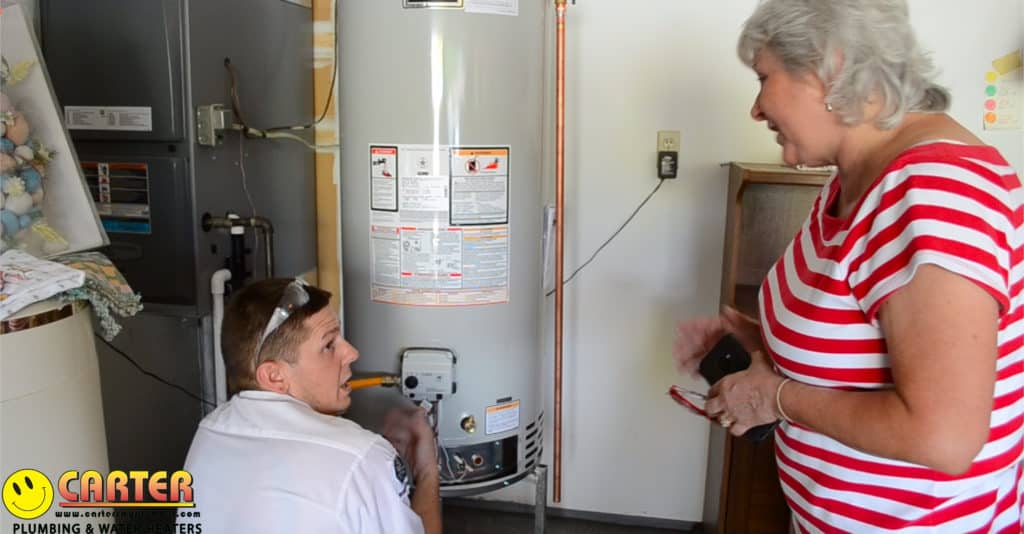
How Much Should You Spend to Repair a Water Heater?
So far, we’ve been discussing problems common to water heaters. The first step toward addressing your issue is to figure out what’s causing it. A Carter professional plumber can assist you with this.
Next, you’ll need to think about heater repair vs. replacement. Use our previous guidelines to help with this. To recap:
- If your unit is under seven years old, you’ll likely want to repair it.
- If it’s more than 9 years old, you should replace it.
- If it’s somewhere in between, get a recommendation from your plumber.
As you consider water heater repairs, there are several factors that can impact the price. Here are just a few aspects to think about.
- Cost of labor. The pricing of water heater repairs can be variable. One of the big factors is cost of labor. A plumber may charge as little as $40 hourly. Or, they may charge more than $150. Repairing a heater usually takes two hours or less. However, this too can vary by the nature of the repairs.
- Make and model. The make and model of your unit also come under consideration. Some units are simply more expensive. Their replacement parts may also be on the pricier side. This accounts for some fluctuation in repair costs.
- Quality of work. It’s good to look for an affordable plumber. Find someone who will give you a bargain. But also remember that quality counts. A more experienced and reputable plumber may charge a little more. Paying a low price to a bad plumber isn’t always a bargain. After all, you may wind up with an issue that recurs.
These are just a few of the factors that can determine the cost of water heater repairs. Of course, the biggest factor of all is which part needs to be repaired or replaced. That’s what we’ll discuss in the next section.
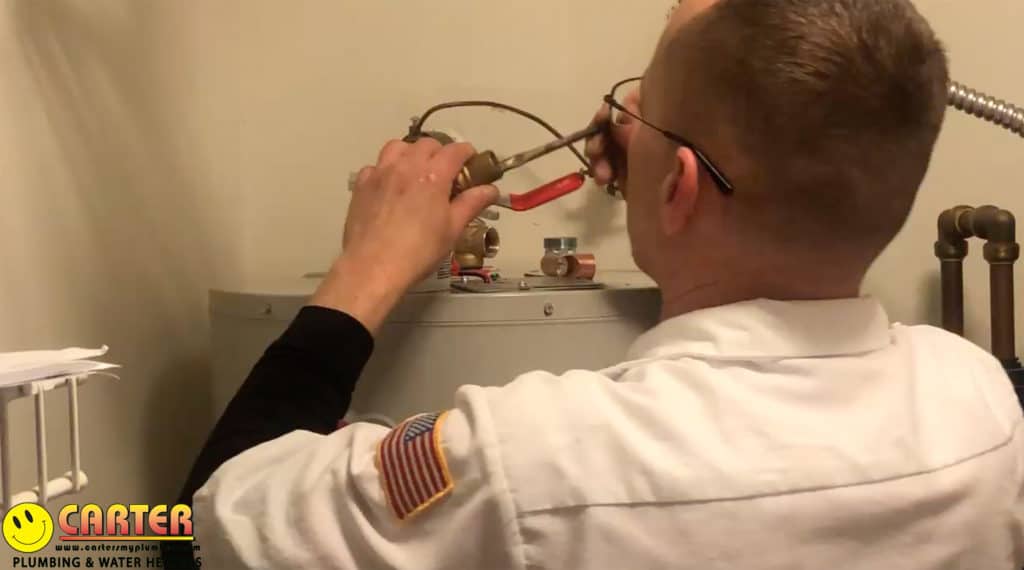
How Much Does It Cost to Repair or Replace a Part?
When you have your electric unit repaired, it will usually involve one of five major components:
- Heating element
- Thermostat
- Anode rod
- Dip tube
- Pressure relief valve
We have touched on each of these components already. Some repair jobs may involve other parts of the water heater. However, 90 percent of the time, the issue will be with one of these parts.
Heating Element
If you have a problem with your element, it will probably cost between $200 and $300 to fix it.
Most electric water heaters come with two heating elements. One is at the bottom of the tank. The other is positioned at the top of the tank.
An electrical current run through each element. This causes them to heat up. In turn, this heats the water inside the tank.
Various things can cause the elements to stop working. Over time, they may burn out. They may also become shorted. Often, bad elements will cause your circuit breaker to trip. If you often must flip the breaker back on, that may indicate a bad heating element.
The good news about elements is that they usually only cost $20 or so. Replacing one takes time, which means there is likely to be a higher cost of labor. You may spend up to $300 total. In most cases, this will be a long-lasting repair. Element replacement isn’t something you should have to do too often.
Thermostat
You may also run into problems with the thermostat on your unit. The cost to repair or replace one is usually $150 to $200.
Most heaters actually have two thermostats. Each one corresponds with one of the elements. If either thermostat goes bad, the water won’t heat as efficiently.
The lower-most thermostat handles most of your water heating. If you have an especially big load of hot water, the upper thermostat will kick in. If either one goes out, you could notice that your hot showers don’t last as long. Or, there may be too much cold water mixed in with the hot water.
Again, the parts themselves are inexpensive. A replacement thermostat will only run $20 to $30. Once labor is taken into account, you’re probably looking at $200 or so. (Again, please keep in mind that these numbers reflect general estimates, not guarantees.)
Anode Rod
Sometimes, heaters fail due to mechanical issues. But sometimes, it’s simple wear and tear. Over time, units become corroded. If your unit is visibly corroded, it may be too late to save it. You may need to go ahead and spring for a replacement.
Anode rods actually prevent corrosion. They extend the life of your unit. The average anode rod will last about five years. It should be replaced to help keep your unit safe against erosion.
An anode rod costs about $50. Some homeowners may feel comfortable replacing it themselves. If not, call a professional plumber, who can assist. The cost of having it replaced professionally may be around $250 or $300.
Dip Tube
A faulty dip tube may cause your heater to stop working. Replacing one yourself may cost as little as $10. If you have it done by a professional plumbing company, you can expect to pay around $150.
What is a dip tube, exactly? This is the pipe that transfers cool water from the top of the tank, back down to the bottom. There, it can be reheated by the lower element. Over time, this tube can get worn out. It may even spring a leak. If this happens, cool water will be mixed in with hot water. This reduces the overall water temperature.
This is another instance where the part itself is not too pricy. Most of the time, this is a simple and straightforward repair.
Pressure Relieving Valve
Finally, we come to the pressure valve. This is another small part of the heater that can sometimes fall into malfunction. Repairing this can cost anywhere from $20 to $200.
This valve does exactly what its name suggests. It releases excessive pressure from your tank. If the valve breaks, the tank may begin to leak.
There are different factors that could cause the valve to go bad. Sometimes it just gets worn down. In other cases, it may have too much sediment build up. Either way, this is usually a matter to be handled by a professional.
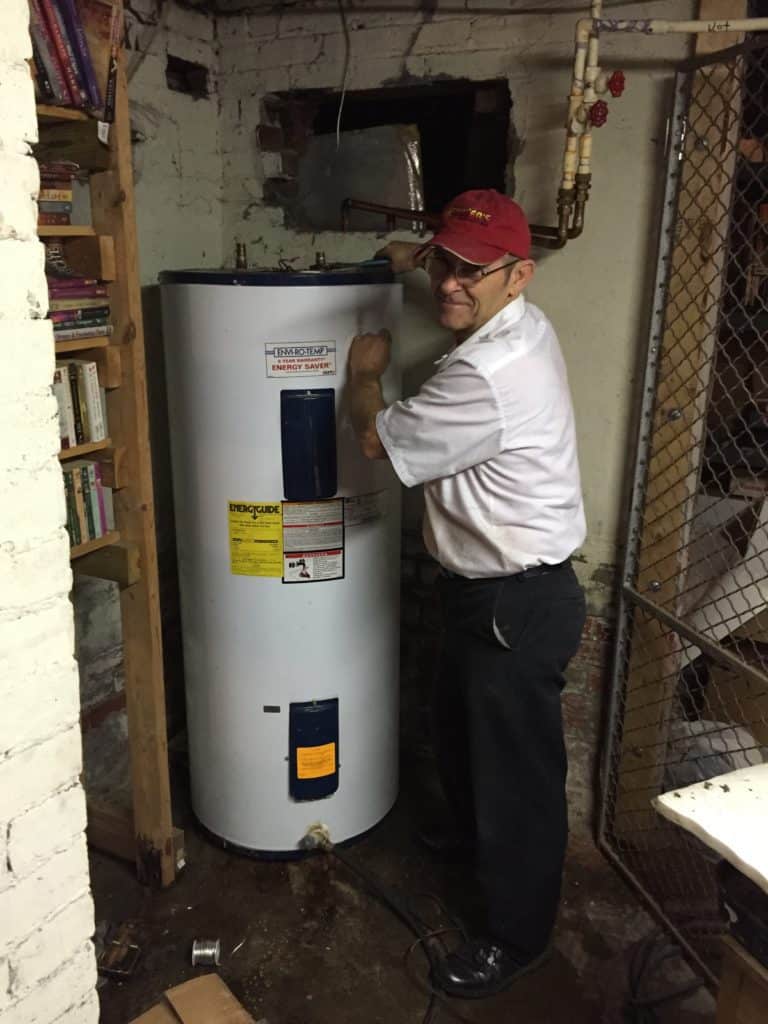
What About Issues with Gas Heaters?
So far, we’ve primarily focused on water heaters that are powered by electricity. However, gas water heaters can present their own issues and concerns.
When gas heaters have issues, they are usually related to the power source. Specifically, a gas heater may run into issues with any of the following components:
- Thermocouple
- Pilot light
- Gas control valve
Gas water heaters can be a little more difficult to assess than electric water heaters. If your gas heater is not working, you may want to hire a professional plumber. Your plumber will be able to accurately diagnose the underlying issue.
As for the average cost of gas heater assessment, here’s a brief rundown.
The Cost of Relighting the Pilot Light
It’s not uncommon for a water heater pilot light to go out. This can result from a temporary disconnection of the gas. Additionally, a pilot light can blow out over time. A plumber can help reignite the pilot light. They will charge you an hourly fee of $40 to $150. This is usually a fairly brief project, and may just take an hour.
You may wish to save yourself a few dollars by relighting the pilot light yourself. Only attempt this if you can completely follow the safety manual that accompanies your water heater. There are real dangers to playing with gas water heaters without the right precautions.
If you attempt to relight the pilot light and it doesn’t work, there may be another problem. Most likely, this is a problem with your thermocouple or gas control valve. See below for more information about these potential repairs.
The Cost of Replacing the Thermocouple
Thermocouples serve a simple purpose. They detect whether the pilot light is lit. This in turn releases the gas control valve. Essentially, this just turns on the gas.
If the thermocouple doesn’t work, it won’t be able to detect the pilot light. As a result, it will not be able to release the gas. If you have a faulty thermocouple, it will be impossible to reignite the pilot light.
If your thermocouple goes bad, there is only one thing to do: Replace it. If you hire a professional plumber to do this, it may cost up to $200 for the labor.
This is another repair you may wish to attempt on your own. The part itself should cost around $120 – $130+. If you attempt this, make sure you shut off the gas before you get to work.
The Cost of Replacing the Valve
Finally, we come to the valve. What is the average cost of replacing the gas control valve? This is one of the more expensive fixes for a gas heater. It may cost between $300 and $500.
A couple of notes: One, this is a harder task than the two we previously mentioned. It’s less likely that you can do it on a DIY basis. Two, if you have a malfunctioning valve, that means your unit is dangerous. We recommend shutting off the gas supply. Then, call a plumber right away. This qualifies as an emergency service need.
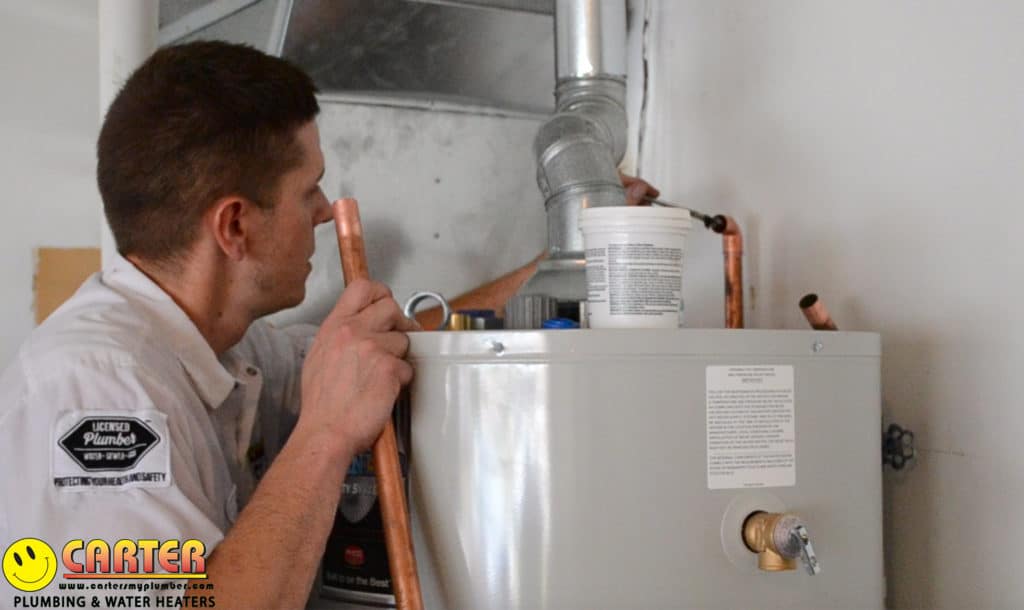
Additional Considerations for Water Heater Maintenance
As we come to the end of our guide, there are a couple of additional points to address. Understanding these points can make you a more responsible water heater owner.
Flushing Your Water Heater
Through daily use, your tank may accumulate debris and sediment. Over time, this sediment builds up. Eventually, this impedes your unit from working the way it’s supposed to. If your heater becomes noisy, that might mean there’s a sediment build-up.
You can avoid this problem by draining your tank on a regular basis. This is pretty easy to do. Most tanks will have a release valve where you can eliminate surplus water and sediment. Check out your owner’s manual for instructions on how to do this safely.
It’s recommended that you flush your tank at least once each year. If you notice sluggish performance, consider draining it more frequently.
If you are not comfortable draining the tank by yourself, you can hire a plumber. This is easy work, and a plumber will usually do it promptly. You’ll just need to pay their typical hourly rate.
One way or the other, be sure you attend to this key maintenance task.
Choosing a Replacement Water Heater
In some instances, it doesn’t make financial sense to repair your unit. We’ve mentioned this already: If your heater is close to the 15 year mark, it may be smart to replace it.
As you consider a new water heater, you’ll have several decisions to make. Not all water heaters are created equal. one decision you’ll need to make is whether you get a tankless water heater or one with a tank.
Both types of heater perform the same basic function. Namely, they supply your household with hot water. They go about it in different ways. A heater with a tank will store a certain capacity of hot water. Usually, this is 40 or 50 gallons. A tankless water heater doesn’t store water. Instead, it quickly heats water on demand, though a system of heating coils.
The average cost of tank-style installation is $1100 for a 40-50 gallon unit. Of course, this can change if you opt for a much larger size. The average cost of a tankless installation is closer to $3,500.
When thinking about your new water heater, there are several considerations to keep in mind.
Tank Heaters
- PRO: It’s much less expensive than a tankless heater.
- PRO: Installation is much quicker.
- PRO: The tank can handle a large volume of water.
- CON: It’s not as energy efficient, as it heats water even when you’re not actually using it.
- CON: The tank occupies more physical space in your house.
- CON: To install it, you need an indoor location with an elevated platform.
- CON: Tank-style heaters usually don’t last quite as long as tankless ones do.
Tankless Heaters
- PRO: Tankless heaters are much more energy efficient. In fact, they can save you up to 25 percent on your annual water bill.
- PRO: Tankless heaters experience just 5 percent energy loss, compared to 30 percent for tank-style ones.
- PRO: You’ll always have hot water when you need it.
- PRO: You can install a tankless heater almost anywhere, even outside.
- PRO: Tankless heaters tend to last longer, sometimes up to 20 years.
- PRO: Tankless heaters take up less physical space.
- CON: They are much more expensive on the front end.
- CON: Installation is more complex and time consuming.
- CON: Some homes may require multiple tankless water heater units. This is obviously a more significant expense.
For more details please visit our tankless water heater installation cost article.
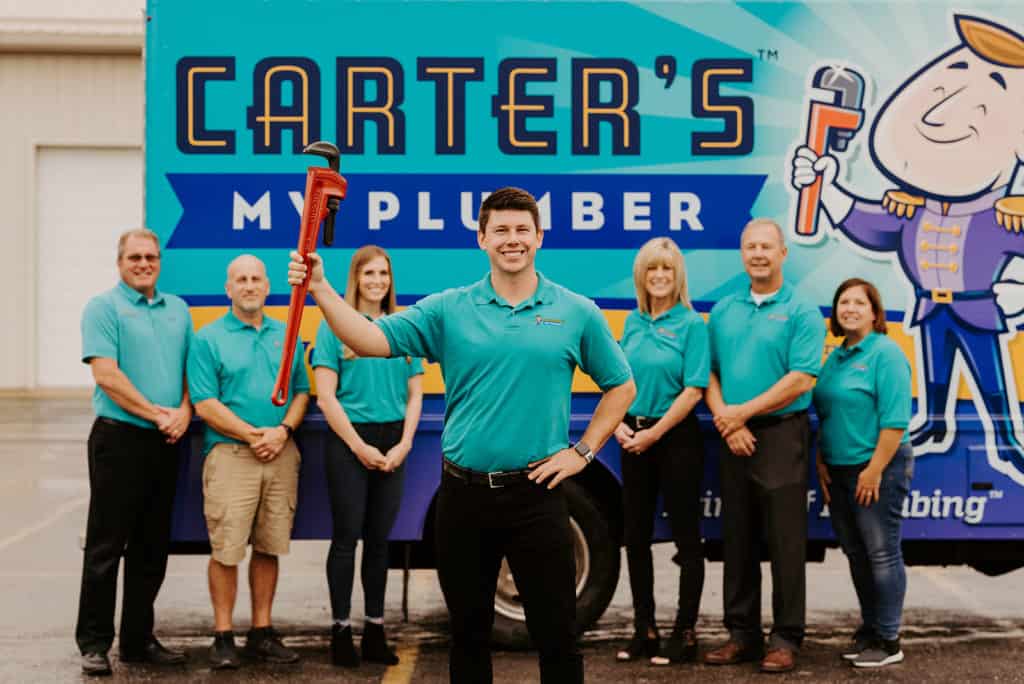
Hire a Water Heater Replacement and Repair Company in Indianapolis area
The bottom line: Homeowners depend on functional water heater units. If your water heater goes out, it diminishes your quality of life considerably. Prompt water heater replacement or repair is a must.
Do you have a water heater that needs to be repaired or replaced? Or do you have further questions about the cost of water heater repair work? Contact Carter’s My Plumber to speak with us about repairing your old water heater. Or, ask us about getting a new water heater! We provide water heater repair in Indianapolis, water heater repair in Greenwood, IN, Fishers Indiana, and Carmel Indiana.
The post Water Heater Repair Cost Guide: Don’t Pay Too Much! (2025) appeared first on Carter's My Plumber.
How to Choose a Sewer Repair Service in Indianapolis: Local Expertise Matters 9 Jan 2025, 3:52 pm
When you are facing a sewer problem, timely repairs are essential to prevent expensive property damage as well as potential health hazards.
In Indianapolis, unique challenges like changing weather, aging infrastructure, and shifting clay soils make sewer line repair issues more complex. These factors, in turn, can lead to common problems such as root intrusion, pipe collapses, and drain blockages.
Addressing these complications requires more than basic plumbing knowledge alone–it demands local expertise. Choosing a sewer repair service familiar with the city’s specific conditions ensures efficient, durable solutions tailored to your individual needs.
For reliable results, finding the best plumbing company in Indianapolis is important.
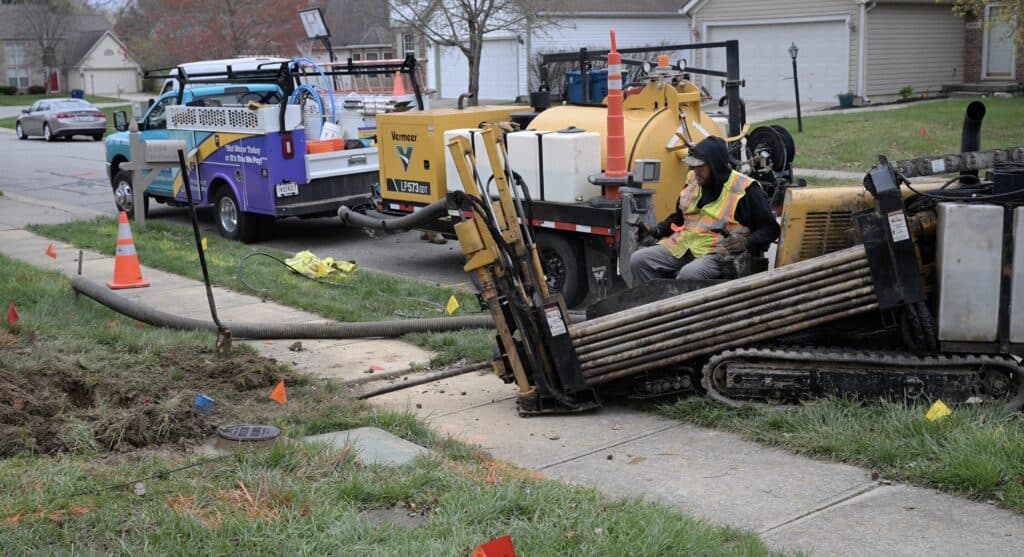
Key Criteria for Choosing a Sewer Repair Service
Experience and Expertise
When choosing a professional plumber, seek out companies that possess a solid reputation in the Indianapolis area. Local expertise matters because seasoned pros are more familiar with the city’s common sewer problems, such as tree roots and clay pipe deterioration.
Check online reviews and ask for references when gauging the company’s track record. Additionally, inquire about their experience with similar issues to confirm they have the knowledge and skills needed to effectively handle your sewer line replacement.
Licensing, Certification & Insurance
It’s also important to work with certified plumbers when selecting a sewer repair service as this improves the chances that the job will be done safely and in compliance with local codes.
Proper licensing demonstrates that the company meets industry standards and has the needed expertise to perform the repairs you require.
Also, comprehensive insurance coverage protects you as well as your property in case of accidents or damage that occurs during the repair process.
Verifying all of these credentials can give you peace of mind and help avoid costly problems or other issues in the future.
Modern Techniques & Equipment
Modern sewer repair services offer advanced techniques, including trenchless sewer repair, which eliminates the need for heavy excavation and digging.
This minimally invasive method uses equipment to repair or replace damaged pipes without tearing up yards, driveways, or landscaping.
Trenchless solutions not only save time and minimize disruption but also provide durable, long-term results.
For both residential and commercial properties, choosing a skilled plumber that uses the latest technology ensures best-in-class repairs with minimal impact to your property.
Responsiveness & Emergency Services
When facing sewer issues, prompt service is center to preventing extensive property damage and costly repairs.
A responsive professional plumber can quickly assess and mitigate problems prior to escalation.
As such, look for companies that offer 24/7 emergency services, guaranteeing help is readily available whenever unexpected sewer failures occur.
Choosing a repair service with round-the-clock availability lessens stress and anxiety–and protects your home or business from unnecessary disruption and expense.
Benefits of Choosing a Local Sewer Repair Expert
Choosing plumbing professionals in Indianapolis who are experts offers multiple advantages that can save you time, money, and frustration.
Here are some key benefits of making the choice to partner with a local sewer repair expert from square one:
- Knowledge of Indianapolis-specific challenges: Familiarity with local soil conditions, weather patterns, and common sewer problems ensures better and longer-lasting solutions.
- Faster service: Local companies can arrive promptly, which reduces delays and minimizes property damage.
- Expertise with regional regulations: Understanding permits, codes, and inspection requirements streamlines the repair process.
- Stronger community reputation: Local businesses rely on positive word-of-mouth and accountability to maintain trust with customers.
- Personalized service: A local plumber is more invested in building long-term relationships with homeowners and businesses in the area.
At the end of the day, choosing a trusted local plumber will provide you with customized solutions and dependable service when you are faced with sewer pipes that need immediate attention.
Questions to Ask Before Hiring
Prior to signing on with a plumbing company in Indianapolis, it’s wise to do your due diligence and ask these questions:
- What’s your experience with sewer systems in Indianapolis? Local knowledge ensures they understand what you’re dealing with.
- Are you familiar with local permits and inspection requirements? Compliance is crucial when avoiding delays and fines.
- Do you offer a warranty on your work? A warranty not only offers peace of mind but will protect you from future repair costs.
- What repair methods and technology do you use? Advanced techniques like trenchless repair are always preferred.
- Can you provide references from happy customers? Positive feedback from other people who have used the service reflects quality and reliability.
Partner with a Reputable Plumber in Indianapolis
Don’t wait for a minor sewer issue to become an expensive disaster–take action now.
For reliable, high-quality repairs, turn to Carter’s My Plumber for sewer line replacement in Indianapolis. Contact our team today.
The post How to Choose a Sewer Repair Service in Indianapolis: Local Expertise Matters appeared first on Carter's My Plumber.
Innovative Sewer Repair Technologies Used in Indianapolis 18 Dec 2024, 6:31 pm
Aging sewer systems pose significant challenges to infrastructure around the country–and Indianapolis is not an exception. However, modern solutions are transforming how sewer line repairs are completed. For instance, innovative approaches like trenchless repair, including Cured-in-Place Pipe lining (CIPP) and pipe bursting, offer minimal disruption, abbreviated repair times, and cost-effective solutions when compared to traditional methods. Additionally, many of these approaches do not require extensive digging like traditional repairs do, which offers customers increased peace of mind.
If you’re facing sewer line issues, it’s best to partner with some of the best plumbers in Indianapolis. Carter’s My Plumber specializes in a wide range of sewer repair methods, including trenchless technologies. Through these advanced techniques, we are proud to offer reliable, efficient repairs that will save you time and help minimize labor costs. Trust our experts to keep your home or commercial property’s plumbing running smoothly.
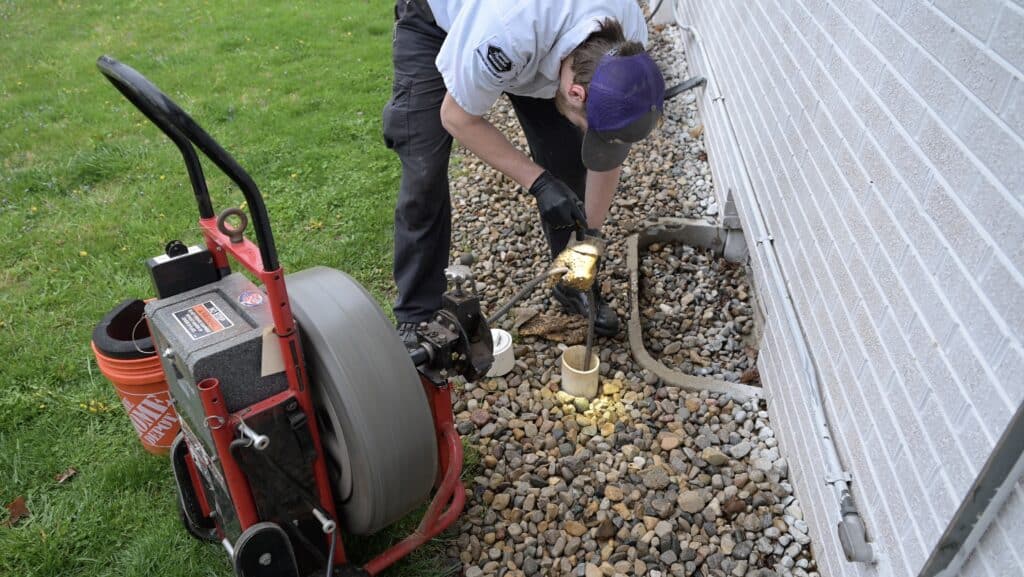
The Need for Innovation in Sewer Repairs
Northwest Indiana’s aging municipal sewer infrastructure faces many challenges, including leaks, tree root intrusion, and antiquated sewer pipes. These plumbing issues threaten homes, commercial customers, and the environment.
Furthermore, these issues not only disrupt daily life but also pose long-term risks and repair costs in the thousands of dollars if left untreated.
However, traditional sewer repair, such as “dig and replace” methods, while effective, are costly, time-consuming, and require extensive excavation, often tearing up streets, driveways, and yards.
Dedicated plumbing company organizations, like Carter’s My Plumber, now offer innovative trenchless technology that is faster and less disruptive, helping satisfied customers with sewer repair service that enables them to get their lives back to normal.
Trenchless Technologies: A Game Changer
Trenchless technology refers to new sewer repair methods that can fix or replace sewer lines without the need for extensive excavation. Unlike traditional sewer line repair methods, trenchless solutions offer minimal disruption to traffic, landscapes, and personal or commercial property. They are also faster, more cost-effective, and eco-friendly.
Some Key Methods Include:
Cured-in-Place Pipe Lining: CIPP involves inserting a flexible, resin-saturated liner into existing sewer pipes, which is then cured using heat or UV light to create a durable, seamless new pipe within the old one. This method not only extends the lifespan of the drain lines but also smooths its interior, enabling proper flow and reducing the chance of future sewer system backups. In Indianapolis, best-in-class plumbing companies are turning to CIPP as one of the advanced methods for repairing damaged pipes.
Pipe Bursting: Pipe bursting is ideal for severely damaged sewer lines. This trenchless technique works by breaking apart the existing pipes while simultaneously pulling a new, durable pipe into place. This advanced method requires minimal excavation, allowing for faster replacement services and reduced downtime, making it a popular option for Indianapolis homeowners and business owners.
Hydro Jetting: This is an advanced method that centers on drain cleaning and clearing out blockages, debris, and buildup within pipes. It serves as both preventative maintenance and is used in restoration processes. Furthermore, it is a process that ensures Indianapolis neighborhoods have clean, functional sewer lines leading to high levels of customer satisfaction.
Robotic and Smart Technologies for Precision Repairs
Advanced tools like robotic cameras and remote-controlled repair robots are revolutionizing sewer repair in Central Indiana.
These technologies provide accurate diagnostics by inspecting and mapping sewer lines, identifying issues with pinpoint precision. Additionally, robotic solutions enable targeted repairs, reducing extensive excavation and saving time and money.
Plumbing contractors are adopting these tools to ensure the delivery of efficient, cost-effective solutions, confirming long-term infrastructure and avoiding the need for a future visit, which ultimately contributes to best-in-class customer service.
Environmental and Cost Benefits of Innovative Trenchless Technology
Advanced methods in sewer line repair significantly reduces the carbon footprint by minimizing excavation and material waste.
These methods are eco-friendlier and more cost-effective than traditional sewer line repair. In turn, municipalities, business owners, and residents save money through lower labor costs and restoration expenses.
Additionally, durable solutions like trenchless repairs extend the lifespan of sewer systems, reducing the need for frequent maintenance and costly future visits.
This long-term approach ensures sustainable infrastructure while delivering substantial financial and environmental benefits for Indianapolis.
Partner with Skilled Sewer Contractors in Indianapolis
The infrastructure of Indianapolis is being transformed via innovative sewer repair technologies.
If you’re experiencing sewer issues, trust Carter’s My Plumber for cutting-edge sewer repairs that minimize disruption and provide long-lasting results. Contact our team today to ensure your plumbing system stays reliable and environmentally friendly.
The post Innovative Sewer Repair Technologies Used in Indianapolis appeared first on Carter's My Plumber.